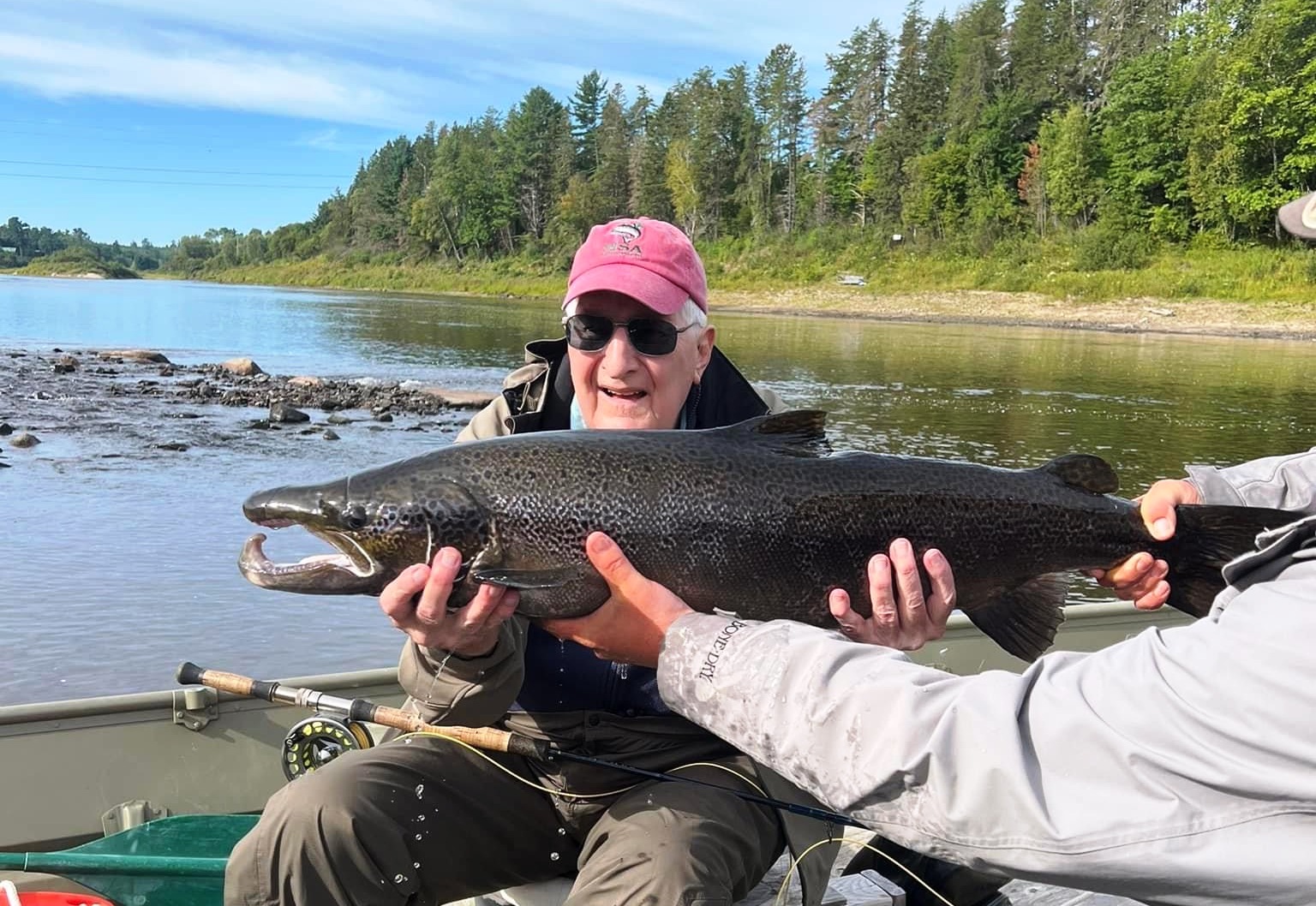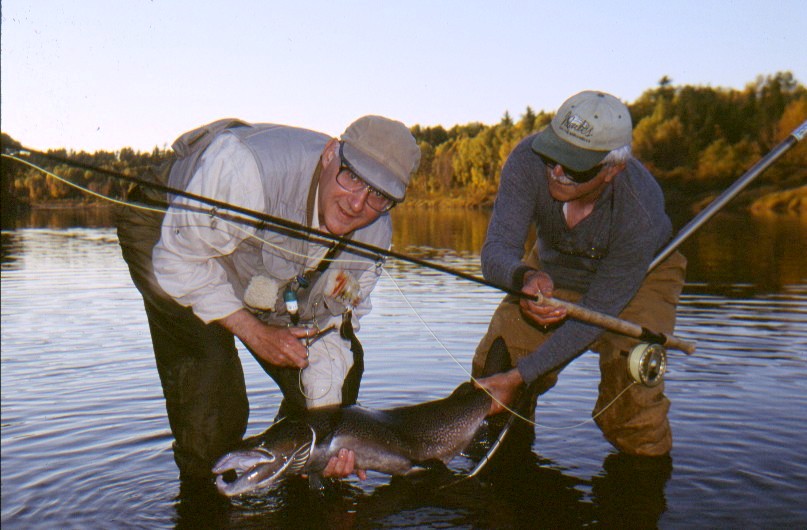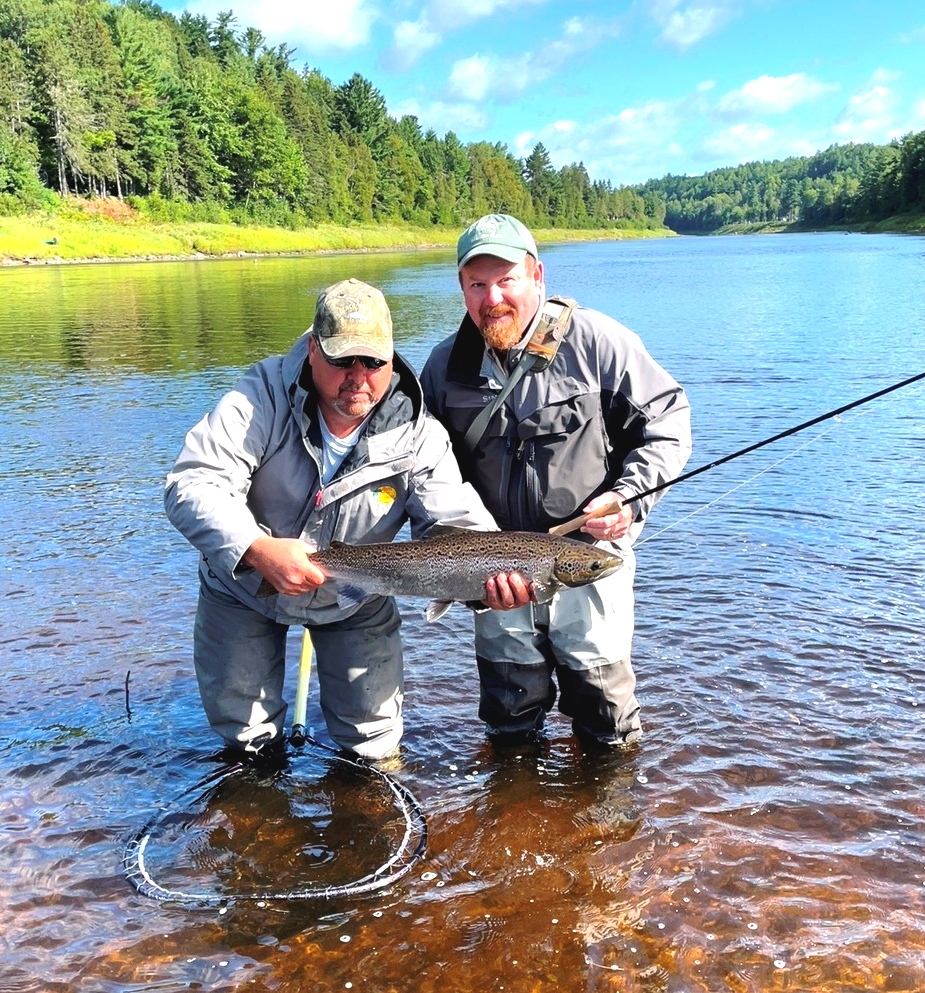
Fall Begins 2024 Miramichi Salmon Blog

Long time patron of the MSA and member of the BBSC, Kit Barrows caught this beautiful buck salmon today on the SWM. Note the switch rod across Kit’s lap. Fall action is underway.
Fishing Friends –
Here is the “Fall Begins 2024 Miramichi salmon blog.”
Miramichi Fishing Report – In the last few days I have heard from lodge owners, guides and fishermen from all over the Miramichi system. In a nutshell, very few new salmon have arrived in the Miramichi since July until perhaps very recently. This isn’t unusual in that August through the end of the first week in September is historically a very quiet period in the annual salmon run. Statistically, the fall run does not begin on September 1. The pick-up in numbers actually starts with the second week in September, and every week after that it builds with the first week of October being the best week of the fall run, and one of the two or three best weeks of the entire season. The second week in October is right behind it, and slightly ahead of the last week in September. That is the statistical average, though, and individual years can vary drastically from that.
That said, we have a current state of affairs that can best be described as a tale of two rivers – or at least two different sections of the same river. The Miramichi’s upstream and headwaters areas need water badly. Rocky Brook manager Wayne O’Donnell says that fish holding in their pools are mainly left over from the summer run, and they are stale and hard to catch. He did say, though, that they are catching a few each day, just less than their normal pace. He also added that just today anglers reported seeing a few bright grilse jumping. Wayne expressed concern about grilse numbers since only about 20% of their catch for the season have been grilse – an unusually low percentage. I communicated with Shawn Betts of Sutters Salmon Club and Karl Wilson of Wilson’s on the Miramichi, and they were far enough upriver to be in the same, very low water situation.
On the lower river, especially on the SWM below the Cains, water is also low, but not unusually so, and there are many, good holding pools both public and private to choose from that can gather up what is at the moment a trickle of incoming fresh fish.
Foremost among such pools is the famous Cains and SWM junction pool at Black Brook. Further up the Cains – which has had a comparatively decent amount of recent rain over its watershed is a stretch running from Salmon Brook on down to Brophy. There are salmon in these pools, and some have recently been angled in most or all of them. Anglers fishing the lower Cains on Sunday said that they began seeing some bright grilse jumping.
Eddie Colford of Black Brook told me that he recently was seeing quite a few fish though they were reluctant to take. The fish that have been caught, though, appear to be quite fresh according to the guides and photos.
Fall salmon fishing discussion – I’d like to take a paragraph or two here to relay some memories of fall fishing from my own experiences, and what I have heard from others who have fished the river since before my time.
Historically the biggest Miramichi runs have come during July. The second and third weeks of July were always the peak of the grilse run. The fall run – early September to October 15 – was normally slightly smaller than the summer run, but often had more large salmon in it. Jason Curtis loved to quote the old saying that fish run up the Miramichi but creep up the Cains. I would say that the exception to that is in the fall. If you have a low water fall there is a constant trickle of new salmon entering the river from the estuary. The great majority of these fish populate the lower river holding pools from Black Brook all the way down through the Rapids to Quarryville. I remember Jason saying that when he was a boy he liked to drift in his canoe from the Jardine Pool at the upriver end of Curtis property in Blackville, down through Campbell’s and Keenan’s until he reached the deep, slow water at the bottom end of Keenan’s. He said that for the whole distance the bottom was so covered with salmon that it was hard to see a spot for another one to take up a lie.
The closest I ever came to seeing that was the first week in October, 2003, my first year at Campbell’s. It was low water and no trouble at all to simply wade across the head of the pool to Keenan’s on the other side. It was typical Indian summer, and the days were full of bright sunshine. We didn’t drift over the pool, Willy Bacso was death on any such notion of disturbing the heart of the pool. I did, though, wade out on the Campbell side where a bar edges out then drops off into a relatively deep center run. When I got out there I could see the white dots from the opening and shutting of the mouths of dozens of salmon. When the light got low in the evening the fish began to jump. It was not at all unusual for 4 or 5 fish to be in the air simultaneously, and there were constantly fish showing for at least a couple of hours. Catching was another story, but with enough effort you could extract one or two each session, and occasionally they would bite a little better than that.
There was no sure-fire secret to success that I know of. We just continued to cast relatively small flies during low water conditions; sometimes dry flies worked better than wets, but that seemed to change around the end of September. In rising water, or if the water was up a bit a really large streamer will often be the ticket. In the slower pools of the Cains a streamer made of marabou, not stripped, but cast straight across and just allowed to undulate its way across the pool will sometimes catch fish, especially if presented on an intermediate tip.
At the end of the week it began raining one late afternoon and rained hard all night and into the middle of the next day. By morning the river was colored and raising fast. Campbell’s Pool was seething with fish jumping crazily, until one after another they left their lies and set a course for upriver spawning areas. This was of course going on all down through the Rapids too, and fish were constantly going by us. It was an unforgettable sight, and it was the result of all the stars lining up just right.

It is hard for me to see this photo, from that great week in October 2003, is an oldie but a goodie, but that’s just what it is. The fish was my first, large, Miramichi hookbill. I remember it like yesterday. My good friend and guide, the late Willy Bacso is on the right of the photo holding my rod.
I sure hope to see salmon fishing like that on the Miramichi again in my time.
Trap Numbers to date
The Millerton and Cassillis fish traps on the SW and NW Miramichi captured 139 and 58 salmon respectively. These are very poor numbers by early 2000 standards but are still reasonable compared to some other more recent years. Remember that you need to multiply these by something like 20 to get an approximation of the actual run. Grilse numbers of 44 and 26, though are just unprecedentedly bad. None of this changed much in August. August is normally the slowest time for new salmon to enter the Miramichi. Water temperatures this past August were overly warm for the entire month. There were just four days during the month when the water temps got as low as 20C/68F, and those were all in the last week. The water was low too, not record low, but consistently very low. As a result, only a tiny handful of salmon entered either branch of the river. Hopefully that is now starting to change. Some fresh appearing salmon have been caught in the lower river, and rain is forecast for this coming weekend. That kicks off a showery period forecast to last through Monday.
We’ll see what comes of it, but I sure like the forecast. We don’t want a huge, heavy rain that causes all the waiting fish to blow up to the headwaters at once.
Scotland Salmon Fishing Update
Sir Michael Wigan of the River Helmsdale in the Northern Highlands of Scotland – he spoke at our winter event at MSA US this past Feb – e-mailed me from Scotland. Since he is a better writer than me, I’ve just copied and pasted his note about the fishing in below:
“Helmsdale July catches were alright. June had been above average. Grilse are later and bigger too, up to 7lb., and have been caught into August. August weather dry-ish, and catches poor, but I don’t have proper figures yet. Lots of fish in the Helmsdale now.
The fish counter after immense complications regarding joint-funding with the Scottish government is now done. I have seen camera verification of fish crossing it. It’s like taking a dram after 3 years abstinence — exhilarating! So next season more knowledge and less speculation.
Our electro-fishing figures showed the damage caused by the 6 month tempest of last winter. Lower numbers of fry and parr. Not rock-bottom but lower. The results differed place to place. Nothing unexpected given the high water and endless storms.
I will add that the Helmsdale has long been regarded as one of the two or three best small rivers in Scotland, and it still holds that distinction. Other rivers haven’t necessarily done as well, though I get some reasonably positive reports from further down the East coast on the Tay and Tweed.
Miramichi Salmon Conservation Activity
The report from the Plamu conference back in April is still in the draft stage. Apparently, the attendees get to see the report to decide if it accurately reflects the proceedings. Personally, I’d just as soon read the results as heard by the independent party who was paid to put the report together. One thing is absolutely certain, waiting 5 months to see just a report of what was said doesn’t reflect the serious situation that exists on the river.
Personally, I believe what the scientists are all telling me both on and off the record. There is no mystery either to what is wrong or what needs to be done. The terribly bloated striped bass spawning population is killing the Miramichi’s salmon run by consuming far too many smolts before they can get to sea. DFO has a written doctrine that prohibits one species from being allowed to severely damage another, but DFO has ignored it because they claim there is no proof that the bass are destroying the salmon. Every salmon biologist that I know of disagrees and says the tagging data is proof positive.
To make matters worse DFO has failed to help the salmon by allowing large scale stocking that could help mitigate the problem. It is really just incredible b.s. and it is all going to come to a head very soon.
A few final thoughts
I’m headed up to Campbell’s this Friday, and I don’t expect to return until October 16. I’ll be fishing every day, talking salmon, taking photos etc and will put a lot of info into my daily salmon report which, by the way, I have been keeping up more or less all summer long. Here is the link. https://www.bradburnsfishing.com/miramichi-salmon-report/. If you have any hope of coming up this fall or just want to fish vicariously through the blog, I’ll be doing my best to keep everyone up to date with what is happening on the river.
Thanks for reading and come on up to the Miramichi before this year gets away from you.
Brad Burns





I look forward to your briefings, they never fail to make me feel like I’m there.
Speaking (actually writing) of which, in the off chance that the license I bought for June dates that were shut down due to warm waters, I called the NB Fish & Wildlife to see if I could change the dates to September, to my surprise they did it albeit after being transferred four times before finding the proper decision maker. 🙂 Now, if I could only speak to the proper person about the stripers……
Hey Brad.
Did you see the latest fishing laws on the Margaree?
Catch a bass , kill it , or face a fine for not doing so.
Hmm. Go figure.